|
Featured picture tools: |
These featured pictures, as scheduled below, appeared as the picture of the day (POTD) on the English Wikipedia's Main Page in April 2011. Individual sections for each day on this page can be linked to with the day number as the anchor name (e.g. [[Wikipedia:Picture of the day/April 2011#1]] for April 1).
You can add an automatically updating POTD template to your user page using {{Pic of the day}} (version with blurb) or {{POTD}} (version without blurb). For instructions on how to make custom POTD layouts, see Wikipedia:Picture of the day.Purge server cache
April 1
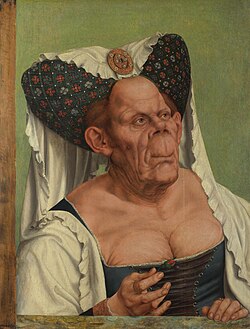
|
A 1513 portrait of an unknown Duchess, possibly Margaret, Countess of Tyrol, by Flemish painter Quentin Matsys. She holds a red flower in her right hand, at the time a symbol of engagement, indicating that she is trying to attract a suitor. This portrait inspired the appearance of the Duchess in Alice's Adventures in Wonderland. The portrait is Matsys' best-known work, and formed half of a diptych. The painting is in the National Gallery in London.
Recently featured:
|
April 2

|
Derek Jeter is an American baseball player for the New York Yankees. He plays shortstop and has been the team captain since 2003. Jeter debuted in the Major Leagues in 1995, and the following year he won the Rookie of the Year Award. In 2000, Jeter became the only player in history to win both the All-Star Game MVP Award and the World Series MVP Award in the same year. In addition, he is a multiple winner of the Silver Slugger and Gold Glove awards, and is the all-time hit leader for the Yankees. Photo: Keith Allison
Recently featured:
|
April 3

|
The frontispiece to a c. 1825 edition of Childe Harold's Pilgrimage, a lengthy narrative poem by Lord Byron. The poem describes the travels and reflections of a world-weary young man who, disillusioned with a life of pleasure and revelry, looks for distraction in foreign lands. In a wider sense, it is an expression of the melancholy and disillusionment felt by a generation weary of the wars of the post-Revolutionary and Napoleonic eras. This poem proved to be quite popular upon its publication in 1812. Byron himself said of this, "I awoke one morning and found myself famous." Engraving: I. H. Jones; Restoration: Adam Cuerden
Recently featured:
|
April 4
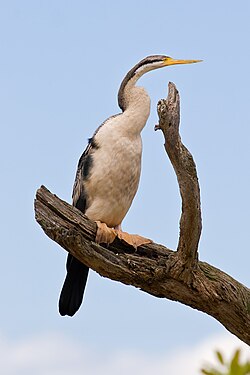
|
The Australasian Darter (Anhinga novaehollandiae) is a species of bird in the darter family, which also includes the American, African, and Oriental darters. Darters are also known as snakebirds, which refers to the snake-like appearance of the neck when they swim with their bodies submerged. Australasian Darters are typically found in freshwater or brackish wetlands in Australia, Indonesia, New Zealand, and Papua New Guinea. Photo: Fir0002
Recently featured:
|
April 5

|
Yumedono ("Hall of Dreams"), a building in the Hōryū-ji Buddhist temple complex in Ikaruga, Nara Prefecture, Japan. The hall, which was built in 739, acquired its common name in the Heian period, in keeping with a legend that says a Buddha arrived as Prince Shōtoku, who had originally commissioned the temple, and meditated in a hall that existed there. Photo: Frank J. Gualtieri, Jr.
Recently featured:
|
April 6

|
The Pipevine swallowtail (Battus philenor) is a swallowtail butterfly found in North and Central America. Its common name derives from the fact that caterpillars of this species feed on pipevine plants, which makes them unpalatable to predators. Because of this, it is mimicked by other butterfly species. Photo: Ryan Kaldari
Recently featured:
|
April 7
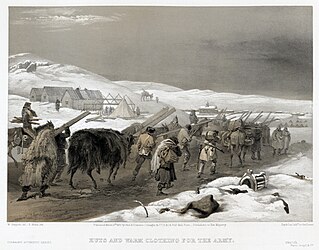
|
A lithograph of a watercolour painting depicting soldiers transporting winter clothing, lumber for huts, and other supplies through a snow-covered landscape, with partially buried dead horses along the roadside, to the British camps, during the Siege of Sevastopol of the Crimean War. In the winter, a storm ruined the camps and supply lines of the Allied forces (France, Britain and the Ottoman Empire). Men and horses became sick and starved in the poor conditions. Artist: William Simpson; Restoration: Lise Broer
Recently featured:
|
April 8
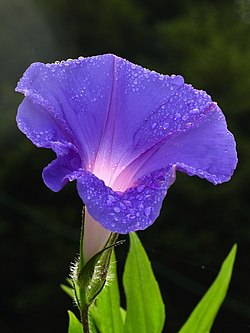
|
The flower of a morning glory plant (Ipomoea nil species pictured). "Morning glory" is a common name for over 1,000 species of flowering plants. Most morning glory flowers curl up and close during the warm parts of the day, and are fully open in the morning, thus their name, although some, such as Ipomoea muricata, are night blooming flowers. Photo: Frank J. Gualtieri Jr. |
April 9

|
San Francisco Bay shrouded in fog, as seen from the Marin Headlands looking east. The fog of San Francisco is a kind of sea fog, created when warm, moist air blows from the central Pacific Ocean across the cold water of the California Current, which flows just off the coast. The water is cold enough to lower the temperature of the air to the dew point, causing fog generation. In this photo, the towers of the Golden Gate Bridge can be seen poking through the fog, and the Bay Bridge is visible in the distance. Photo: Mila Zinkova |
April 10

|
|
The mansion at Wakehurst Place in Ardingly, West Sussex, England. The house is a late 16th-century gentry house that was the residence of Gerald Loder, 1st Baron Wakehurst, who was largely responsible for the garden. He spent 33 years developing the gardens, which take up about two square kilometres (500 acres). The property belongs to the National Trust and is managed by the Royal Botanic Gardens. Photo: David Iliff
Recently featured:
|
April 11

|
Pholiota malicola is a species of fungus in the Strophariaceae family of mushrooms. All of the 1,316 species in this group are saprotrophs, growing on various kinds of decaying organic matter. Photo: JJ Harrison
Recently featured:
|
April 12

|
A c. 1890 Korean illustration of a litter (gama in Korean), a type of human-powered transport, for the transport of persons. Gamas were primarily used by royalty and government officials, or in traditional weddings. Because of the difficulties posed by the mountainous terrain of the Korean Peninsula and the lack of paved roads, gamas were preferred over wheeled vehicles. Artist: Unknown; Restoration: Lise Broer
Recently featured:
|
April 13

|
A Sikh pilgrim at the Harmandir Sahib, known informally as the "Golden Temple", located in the city of Amritsar, Punjab, India. The temple is the best-known of the Sikh gurdwaras and was completed in 1604. In the early nineteenth century, Maharaja Ranjit Singh covered the upper floors of the gurdwara with gold, giving it its distinctive appearance. Photo: Paul Rudd
Recently featured:
|
April 14

|
The Black Swan (Cygnus atratus) is a large waterbird which breeds mainly in the southeast and southwest regions of Australia as well as New Zealand. They are large birds with mostly black plumage and red bills. They are monogamous breeders that share breeding responsibilities between the sexes. Photo: Fir0002
Recently featured:
|
April 15

|
A robber fly (Pegesimallus species shown), an insectivorous insect, feeding on a beetle. There are about 7,100 species of robber flies, all of which use a proboscis to stab and inject victims with saliva containing neurotoxic and proteolytic enzymes that paralyze and digest the insides; the fly then sucks the liquefied meal through the proboscis. Photo: Muhammad Mahdi Karim
Recently featured:
|
April 16

|
The Indian Palm Squirrel (Funambulus palmarum) is a squirrel native to India and Sri Lanka. It is relatively small, about the size of a rat, with three white stripes on its back from head to tail. According to Hindu legend, Lord Rama was so pleased with a squirrel's help in the construction of a bridge at Rameswaram that he stroked the squirrel's back and his fingers left their mark in the form of stripes. Photo: Muhammad Mahdi Karim
Recently featured:
|
April 17

|
The poilu's holiday, December 25 and 26, 1915, a French World War I poster depicting a poilu's Christmas leave from the war. "Poilu", literally meaning "hairy one", is a nickname for French infantrymen. The word carries the sense of the infantryman's typically rural, agricultural background. Beards and bushy moustaches were often worn. The image of the dogged, bearded French soldier was widely used in propaganda and war memorials. Artist: Adolphe Willette; Restoration: Lise Broer
Recently featured:
|
April 18
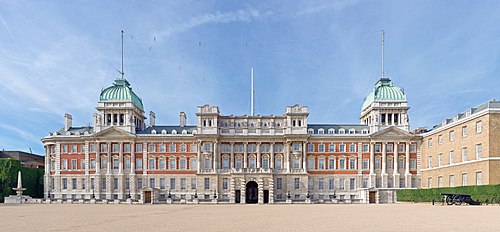
|
|
The Admiralty Extension, built in the late 19th century, is the largest of Admiralty buildings built to house the authority responsible for the command of the Royal Navy in the United Kingdom. Redesigned while under construction to accommodate the extra offices needed due to the naval arms race with the German Empire, it served as the headquarters of the Admiralty until 1964 when it was subsumed into the Ministry of Defence in nearby Whitehall. Photo: David Iliff
Recently featured:
|
April 19

|
A Hamatsa shaman from 1914. The Hamatsa are one of four secret societies among the Kwakwaka'wakw, an indigenous people of the Pacific Northwest coast, who live mainly in Vancouver Island and mainland British Columbia. The Hamatsa practice a cannibalistic ritual, but it is unknown if it is in a literal sense or merely symbolic. Photo: Edward S. Curtis; Restoration: Lise Broer
Recently featured:
|
April 20

|
A depiction of entertainment in Vauxhall Gardens, a pleasure garden that had existed in Kennington, London, England, likely since around the time of the Restoration. The Gardens consisted of several acres of trees and shrubs with attractive footpaths. It was popular with all classes of society and supported enormous crowds. Over the years, the gardens passed through the hands of several owners before finally closing in 1859. Artist: Thomas Rowlandson; Restoration: Adam Cuerden
Recently featured:
|
April 21
|
A panoramic view of Grote Werf, a community in the municipality of Waterland, located on the Marken peninsula in the Netherlands. Marken is a tourist attraction, well-known for its characteristic wooden houses. The island is connected to the mainland by a causeway and was a separate municipality until 1991, when it was merged into Waterland. Photo: Massimo Catarinella
Recently featured:
|
April 22

|
Gustave Doré's depiction of the kiss given by Judas Iscariot to Jesus, identifying him as the one whom the soldiers of the high priest Caiaphas are to arrest. The Gospels state that Jesus foresaw and allowed the betrayal because it would allow God's plan to be fulfilled, but most Christians still consider Judas a traitor. Following this event, Caiaphas condemned Jesus for blasphemy, and the Sanhedrin trial concurred with a sentence of death. Jesus was handed over to the Roman governor Pontius Pilate for execution, who carried out the sentence against his own wishes. Restoration: Adam Cuerden
Recently featured:
|
April 23

|
The Sacred Kingfisher (Todiramphus sanctus) is a tree kingfisher found in the mangroves, forests, and river valleys of Australasia and Indonesia. It is 19–23 cm (7.5–9.1 in) long, and feeds on insects, small crustaceans, fish, small rodents and reptiles. Photo: Fir0002
Recently featured:
|
April 24

|
Concretions on Bowling Ball Beach in Mendocino County, California. A concretion is a volume of sedimentary rock in which a mineral cement fills the spaces between the sediment grains, usually forming an ovoid or spherical shape. This normally occurs early in the burial history of the sediment, before the rest of the sediment is hardened into rock. Photo: Mila Zinkova
Recently featured:
|
April 25

|
A sketch of the Andes in Peru, drawn by Alfred Agate during the United States Exploring Expedition, an exploring and surveying expedition of the Pacific Ocean conducted by the U.S. Navy from 1838 to 1842. The expedition was of major importance to the growth of science in the United States, in particular the then-young field of oceanography. Restoration: Lise Broer
Recently featured:
|
April 26

|
A view of the Ilala district of Dar es Salaam, the largest city in Tanzania, seen at dusk from the Benjamin William Mkapa Pension Tower. The city was the administrative and commercial centre of German East Africa and served as the first capital of Tanzania, but lost that status to Dodoma in 1973. Photo: Muhammad Mahdi Karim
Recently featured:
|
April 27

|
Grant from West Point to Appomattox, an 1885 lithograph by Thure de Thulstrup of events in the military career of U.S. President Ulysses S. Grant, who died that year. Clockwise from lower left: graduation from West Point (1843); in the tower at Chapultepec (1847); drilling volunteer soldiers (1861); the Battle of Fort Donelson (1862); the Battle of Shiloh (1862); the Siege of Vicksburg (1863); the Battle of Chattanooga (1863); appointment as Commander-in-Chief by Abraham Lincoln (1864); and the surrender of Robert E. Lee at Appomattox Court House (1865). Restoration: Adam Cuerden
Recently featured:
|
April 28
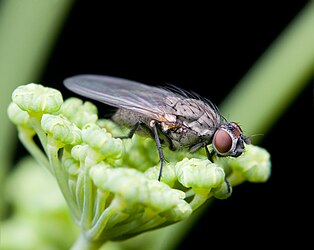
|
Adia cinerella is a species of anthomyiid fly, a large and diverse family of flies whose larvae consume plant material, whether as leaf miners or in the stems and roots. Those species whose larvae feed on roots, especially those of the Delia genus, are often considered agricultural pests. Photo: JJ Harrison
Recently featured:
|
April 29

|
A nautical map of Zwaanendael and Godyn's Bay, a Dutch settlement founded by Samuel Godyn in 1629 in the modern U.S. state of Delaware. Godyn made his land claim to the Dutch West India Company under jurisdiction of the Charter of Freedoms and Exemptions. After a short time, the initial 32 inhabitants were murdered by local Nanticokes and Godyn sold his land back to the company. Map: Johannes Vingboons; Restoration: Lise Broer
Recently featured:
|
April 30

|
A woodcut engraving by English illustrator Randolph Caldecott for the nursery rhyme and cumulative tale "This Is the House That Jack Built", which appeared in an 1887 book of children's stories. The poem does not actually tell the story of Jack building a house, but instead shows how the house is indirectly linked to numerous things and people. It is believed to date back to the mid-sixteenth century, but the first printed edition was in 1755. Restoration: Lise Broer
Recently featured:
|
Picture of the day archives and future dates
